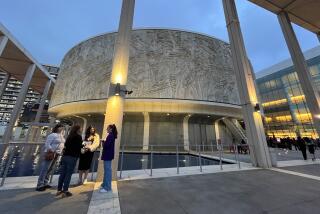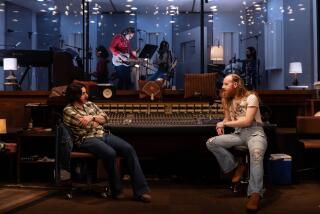Digital theater is all the rage, but could it destroy the live stage?
No one at this point can answer when live performance will come back. Not the medical experts. Not theater owners and producers. And not the unions that represent the creative professionals whose livelihoods are in a state of suspended animation.
Digital is the only safe stage right now. Theaters, fighting for their lives, have been creatively exploring how to connect to their audiences with media technology. Richard Nelson wrote a play for Zoom, celebrated productions from the past are streaming, online benefit play-readings are proliferating and virtual town halls have become the new theater hangout.
Last week Center Theatre Group managing director and chief executive Meghan Pressman moderated an L.A. Theatre Speaks panel on the subject of creating theatrical content for online platforms. The speakers were enthusiastic yet understandably cautious. Digital dangles the promise of salvation yet has a track record of devastating financial disruption. But what other choice is available in a pandemic?
Yuval Sharon, artistic director of the Industry, an innovative opera company devoted to exploring nontraditional performance spaces, said he’s interested in “work that does not feel like it’s an apology” for our inability to gather in person. Digital is less appealing to him as a delivery system “for content we would normally do.” He’s more intrigued by “brand-new work” that is responsive to the tools that are still being discovered.
Fountain Theatre artistic director Stephen Sachs said his focus has been “less about content and more about community.” How, he asked, can the connection of a theater audience be “translated into a digital space?” For Sachs, it’s not about delivering products that can be passively enjoyed. People want to be brought into the process and engage not only with artists but also with their fellow audience members, he said.
Damian Bazadona, founder of the digital marketing agency Situation Interactive, concurred: “People want to be seen. It’s about the idea of connection. Digital tech, if you do it right, which can happen through Zoom, is about connection. … We have to use technology in the same way until we can get back into the venues.”
Oregon Shakespeare Festival artistic director Nataki Garrett said that digital can broaden the reach to marginalized communities who may have felt unwelcome in the “restricted” atmosphere of institutional theater. How, she asked, can we create a space of coming together that is not simply reinforcing audience homogeneity?
Deaf West Theatre artistic director DJ Kurs also is looking to digital for ways of expanding access. But he noted that the struggle continues on the internet, where perhaps “less than 15 percent of online theater is captioned or interpreted or made accessible to the deaf community.”
IAMA Theatre Company co-artistic director Katie Lowes has been heartened by the way the 99-seat theater community has rallied together through weekly online meetings. The support, she said, has been invaluable, as has the practice of thinking about the L.A. theater audience “as a whole” rather than as disconnected fiefdoms.
Geffen Playhouse associate artistic director Amy Levinson acknowledged that in the past, union rules regulating online transmission of theatrical content provided formidable disincentives. The pandemic has reopened these conversations, though she pointed out that the Geffen’s production of “The Present,” the virtual magic show by Helder Guimarães that opens on Thursday, was made easier because Guimarães is a magician and not subject to the same restrictions as stage actors.
In a conference call last week with the leaders of arts, entertainment and media unions, there was broad recognition that these regulations would have to be continually reassessed in light of the current crisis. Union members need work and employers need to to survive. If ever there was a moment to pull together, this is it.
But Sachs worried that the 99-seat theater community might be at a disadvantage in negotiating with Actors’ Equity. He fears that smaller organizations such as the Fountain will be looked upon by the unions “as a less profitable investment or use of their time.” Yet it’s those theaters operating on a shoestring that need streaming most, he contended.
Theater leaders understand that these platforms must be explored on their own terms, that it’s not simply a matter of putting old wine in new bottles. Novel forms must be invented, and Levinson, who understands the resistance as a proud “theater snob” who once looked askance at the use of projections onstage, urged an openness to the way these practices can be integrated even after live theater comes back.
Only a fool would bet against the ingenuity and resourcefulness of theater professionals. The longer this pandemic lasts, the more dynamic and innovative online theater offerings will become. But the risks shouldn’t be underestimated. Many will rejoice when the theaters reopen, but what about the segment of the audience that has grown accustomed to watching plays and musicals on their devices?
Going to the theater takes effort, especially in L.A. You have to deal with traffic. (In the last year, I’ve regretfully declined invitations from friends to Friday night performances at Walt Disney Concert Hall because of the harrowing drive downtown.) You have to pay for parking or deal with the stress of finding a spot on the street.
You also have to deal with the hell, to borrow from Sartre, of other people. Some who are slower and less courteous. Some who cannot resist unwrapping a mint or answering a text. Some who forget to turn off their hearing aids when using an assisted listening device.
Attending the theater is expensive in terms of money and patience. (A colleague with a young child tells me the cost of babysitting is like buying a third ticket.) Even provisionally establishing the idea that you don’t really need to be there is fraught with peril in an age in which gratification is measured in clicks.
Of course, nothing can replace the shared pulse of a theater audience. A screen, no matter how high-definition, cannot approximate the vivid thrill of being there. But already there’s talk of virtual tickets in a future transitional phase, in which part of the audience, still worried about contagion, opts for a livestream of the performance.
I am a great lover of bricks-and-mortar bookstores and will happily rhapsodize on the joys of browsing the tabletops for recommended reading. Yet Amazon has captured more of my business than any retailer. Convenience is hard to resist, and tech giants have reordered our relationship to time.
Digital theater has become a necessity for companies that would otherwise vanish from public consciousness. Artists will no doubt reveal stunning theatrical possibilities in online platforms. But it’s not too early to start worrying about how to put the genie back in the bottle.
More to Read
The biggest entertainment stories
Get our big stories about Hollywood, film, television, music, arts, culture and more right in your inbox as soon as they publish.
You may occasionally receive promotional content from the Los Angeles Times.











